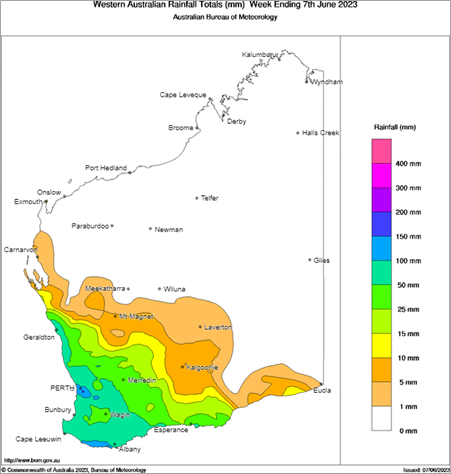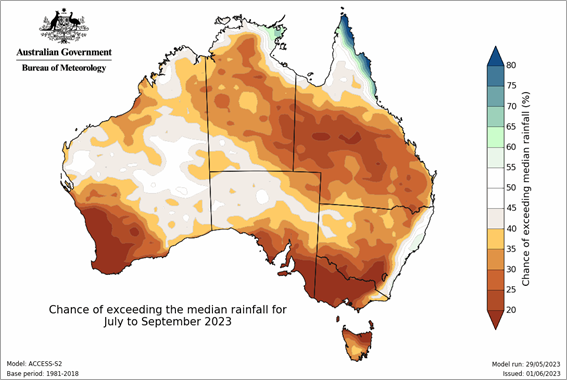The 2023 Grain Season – Crop potential turned around dramatically in four days
The recent rainfall across the grainbelt of Western Australia has topped up crops in the central regions and other areas where crops were up. This is the “break” growers were waiting for in the drier regions to the north and south of the state.
The rainfall across the majority of the WA grainbelt over the last week, has transformed the season’s grain production potential from one of below average, to at least average or above average. A week ago, emerged crops were showing signs of moisture stress and much of the northern and southern grainbelt was dusty and brown. These rainfall events will germinate crops that were sown dry, and those that had emerged will now take off and have reasonable yield potential.
The northern third of the state’s grain growing regions were looking down the barrel of a very poor year up until last week, with few crops emerged and low levels of subsoil moisture. That has since changed with several good falls of rain over several days, in some cases exceeding the average rainfall for the whole of June. The year to date (YTD) rainfall for the whole state, excluding those in the eastern edges of the grainbelt, is now at levels where reasonable tonnages of production are possible.
The “jump” in crops that were up prior to the rains is noticeable, and these crops will recover grain yield potential that was fading during May. The whole of the Kwinana South zone, and the southern portion of the Kwinana Northeast zone are now in nearly as good a shape as this time last year.
The northern portion of the Kwinana Northeast zone and the Geraldton zone are back in the race for average grain yield potential, although these regions are going to need more good winter rains for this to occur.
The west and southern portion of the Albany port zone is behind in growth stages compared to this time in 2022 and have less subsoil moisture reserves. The Lakes district is well behind where it was in 2022, with the majority of crops emerging only on the recent rains. This is not too late for average grain yield potential to be achieved but as much of the crop will be at a similar growth stage, even though later than last season, could mean frost will have a greater impact over a wider area.
The Esperance zone was in desperate need of the recent rains, and the coverage over the region was patchy, with some of the drier areas unfortunately missing out once again. The subsoil moisture reserves from harvest are still there, and the later sown and emerged crops will now be able to get their roots down into it.

Seasonal Outlook
Ian Foster, Department of Primary Industries and Regional Development

Climate Summary
Autumn rain has been mixed over agricultural areas, with some notably dry parts and some with good rain in March and April. May itself was very dry. Climate models had indicated autumn was more likely to be drier than normal.
Rain in early June has been significant, coming from a deep low-pressure system and series of cold fronts (Figure 1). This shows the importance of short-term weather events providing rain despite a drier seasonal expectation. However, there are some parts of the agricultural area that have received less than 20mm for the month to date.
Climate models continue to agree that below normal rain is more likely over July to September for most of Australia (Figure 2). Atmospheric pressure remains likely to be above normal south of Australia, which is associated with lower rainfall over southern WA.
The likelihood of an El Niño event developing in the Pacific Ocean is increasing. BoM has raised the ENSO status to ‘Alert’ and indicated a positive Indian Ocean Dipole event is likely. This is despite some mixed atmospheric patterns in the Pacific, and neutral conditions in the tropical Indian Ocean. Their combined impact is likely to suppress rainfall over much of Australia in winter and spring.
Considering these factors, the seasonal status is mixed. On one hand, early-season rain has been good in most areas, with the timing of June rain being particularly welcome for crops. However, the seasonal rainfall outlook continues to indicate drier than normal conditions are more likely through winter.
The development of climate events in the Pacific and Indian Oceans should become clearer by July, providing a better picture of likely climate conditions in spring.
Additional information is available from:
BoM: Decile rainfall for March to May 2023
BoM: Rainfall outlook for the next week
BoM: Seasonal Rainfall Outlook

Figure 1. Rainfall totals for 1 to 7 June 2023. From Bureau of Meteorology.

Figure 2. Chances of exceeding median rain for July to September 2023, based on model run 29 May 2023. From Bureau of Meteorology.
Geraldton Zone
The rain that was desperately needed, turned up in the last week for most growers. Crops that were up were struggling, and in a large portion of the zone, crops had not emerged. On the heavy country, some crops have needed re-seeding because they were dying from lack of rain or were too patchy to deliver a decent crop. The north-eastern and eastern fringe missed out on the good falls of rain, and some of the light country in the northern areas was starting to blow prior to the rain over the last week.
Very few lupins have been planted in the region this year, and canola plantings have been significantly down over recent years. It is mainly a cereal dominated crop in the north this year.
Many growers chased deep moisture, which has paid off as these crops have emerged with enough plants to give good yield potential. The extra few weeks of growing season this has delivered is critical in the warmer northern portions of the grainbelt. This practice change of chasing deep moisture occurred over a large area of the state this year and while sowing deep is not without its’ own risks, this year it has paid off. There is a big contrast in yield potential between those that did chase moisture and those that did not, and this could end up adding significant tonnes of grain to the 2023 WA total.
Kwinana Zone
Kwinana North Midlands
There has been quite a turnaround in the region from a week ago. Many areas in the Kwinana Northeast, have doubled their YTD rainfall in the last week. There are a few late paddocks that may now be planted on the back of this recent rain. The low rainfall regions however, did miss out with the most eastern areas receiving less than 15mm and the shift from crop area to fallow will be around the 20 per cent mark.
This rain should help to fill in the patchy early sown canola crops, and the dry sown canola that emerged a couple of weeks ago should really get going now.
Pasture paddocks have a tinge of green, and the green is starting to show in the furrows of crop paddocks that were brown a week ago. A lot of growers with livestock were sweating on the rain and are relieved that the extra sheep they were carrying will now have paddock feed from pastures that hung on during the very dry May.
Some early sown crops have had a nitrogen top-up although these are few and far between. The rain will help to fill in the gaps of patchy canola crops, particularly on the heavy country.
Kwinana South
The whole region is looking brilliant with emerged crops freshening up over the weekend and recently sown paddocks received plenty of rain to emerge. The early canola crops are cabbaged up with some starting to form buds. There was a lot of nitrogen applied before the rains on the weekend and growers are confident they now have the moisture to support good crop yields. The country looks brilliant east to west, and is unusually consistent from Meckering through to Merredin.
There is a bit of a patchwork of paddocks right across the zone, with crops up from the early sowing in April and May, and the later 30 per cent or so of paddocks that were sown dry being brown up until now. The recent rain was perfect for those crops already firing with adequate subsoil moisture and was still early enough to give the un-emerged crops a chance of good grain yield potential.
The conundrum now is how to tackle weed control. Because most crops have had no rain since sowing, a flush of weeds is expected following the recent rains, and those crops that are up are past any weed pressure impact on yield. Most weed control will be aimed at keeping numbers down for seed set control to benefit future years.
Kwinana North East
The northern portion of the Kwinana North East region has now had good falls of rain and the mostly brown paddocks will be green by this time next week. Most growers have finished the last remaining paddocks that were being held off waiting to see what eventuated out of these latest weather systems. There is a noticeable number of paddocks left out as you move to the eastern rim of the northern portion of the zone and to the north of the eastern portion of the zone. The area of fallow will be significantly more than in 2022, although it is a bit early yet to tell what the actual area will be.
The eastern and north-eastern fringe of the zone from Buntine down to Kalannie and across to Bonnie Rock had lighter falls of rain of generally less than 20mm. This rain was on top of less than 50mm YTD, hence affected growers are bracing for a below average year. The remainder of the eastern portion of the zone is in very good shape and shows similar potential to this time last year. For crops with subsoil moisture and enough growing season left, the timing of the rain has been perfect and will at least give average or better than average grain yield potential.
Albany Zone
Albany West
The season outlook for the zone has gone from a feather duster to a rooster in four days. Most of the region has had between 80 to 110mm of rain in the last week, completely transforming the outlook for the region. Crops have come to life and the non-existent pastures have greened up within days of the rain. The blue, wilted canola is now green and all of a sudden needing attention with nitrogen and weed control.
The 30 per cent or so of crops sown dry that had not emerged will now be up, which is mostly the wheat portion of growers’ programs. Percentage of crop area split has ended up around the same as in 2022, with a slight increase in canola area and maybe a few pasture paddocks that were intended to be cropped left out to carry the higher-than-normal sheep numbers still on-farm.
Albany South
Crops in the region are now looking very good following the recent rainfall. Crops on the heavier country that had not emerged or were not initially sown due to being too difficult to get the seeders into, will now come up. Crops that were up had nitrogen top-ups prior to the expected rain last weekend and will now take off. Growers were holding off finishing seeding programs to see what the outcome of the cold fronts would be. With most areas receiving 50 to 80 mm, the remainder of the mostly wheat crops will now be sown.
Following the rain, patchy canola crops will improve and pastures that hung on during the dry May, will now be able to support the extra sheep kept on-farm. In saying this, sheep feed will be tight until August.
Around 30 per cent of the area intended to be cropped is yet to be sown. This will now go in once it dries out a little. Most of this is heavy country of which approximately 80 per cent of this is expected to be sown to wheat and the remainder to barley.
Where crops were up, nitrogen has been going out with nice steady rain to wash it in. Earwigs are causing late bug damage and more red legged earth mites are still expected to hatch.
Albany East (Lakes Region)
Rainfall prior to the weekend’s falls was patchy and variable within regions and within farms. The rain that has just come through has lifted totals, and with it, the prospects for the region. Most growers have now put the seeders away, although on the heavy country in the southern areas, a bit more crop will go in following this rain. Even though the rain was “all over the place” and a bit stripey, the second bout of cold fronts has filled in those lighter areas.
Most growers are happy with the rain they have had. Canola was desperately in need of moisture and many cereals paddocks had not germinated. The lake bank country was too hard to sow into prior to the rain and growers can now finish off their programs. Crops are already starting to pop out of the ground, and growers have more confidence in the season that is in front of them. Whilst happy with the rain, growers are not planning for any record breakers as seen in the last two years.
Most nitrogen applications have started as planned, with a percentage held back to play the season.
Canola was patchy up until the rain, and those that were up, are up to 6 leaf and have had a weed spray.
Canola jumped out of the rain with soil wetters. The increase in soil wetter use in the lower rainfall regions has been noticeable this year in assisting to gain a better strike in a drying profile, particularly with canola.
There has been some mice activity in isolated areas that have required baiting.
Esperance Zone
Most growers in the region had less than 10mm of rain for May and were wondering when the next drop would fall. The weekend has changed that significantly and except for the already drier areas around Cascades and the Gums, all other areas of the zone received good falls of rain. The western areas that were drier than the eastern portion of the zone have now received enough rain to get the remaining dry sown crops up and away. The coastal areas are very good and not too wet as yet.
Large areas of country were sown on the angle to get crops up in the drying profile. This, along with chasing moisture deep, is another area of practice change that growers have adopted recently. This year, larger areas of the grainbelt have been sown with these practices than ever before.
Weed control in the canola paddocks has been challenging as the crops have a large range of growth stages due to the staggered emergence following planting, particularly around the use of Triazine.
A lot of nitrogen went out ahead of the rains, and growers will now be concentrating on getting rid of the flush of weeds that are expected to germinate now the country is wet.
Some country has needed double baiting for mice, although this has mainly been in barley stubbles or where there was delayed harvest from moisture or hail damage.